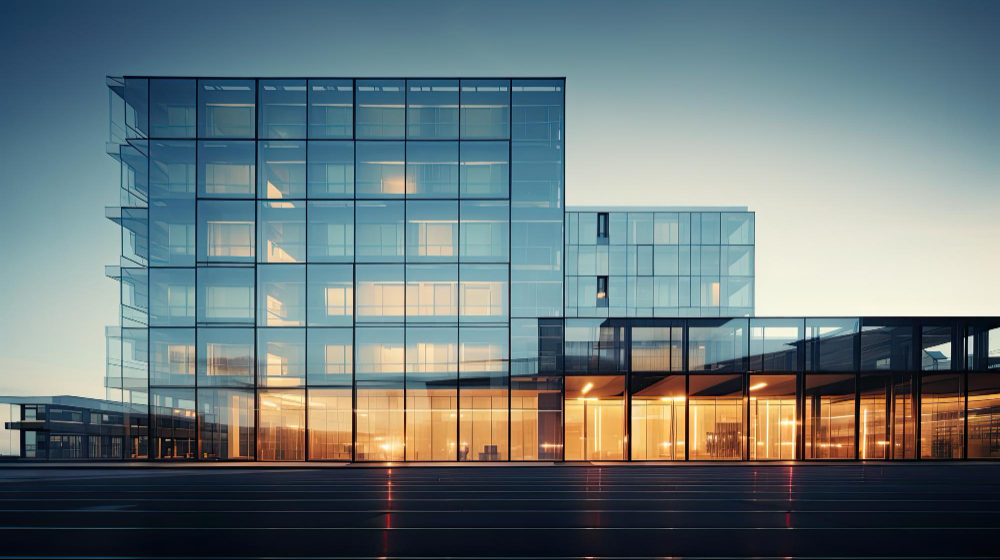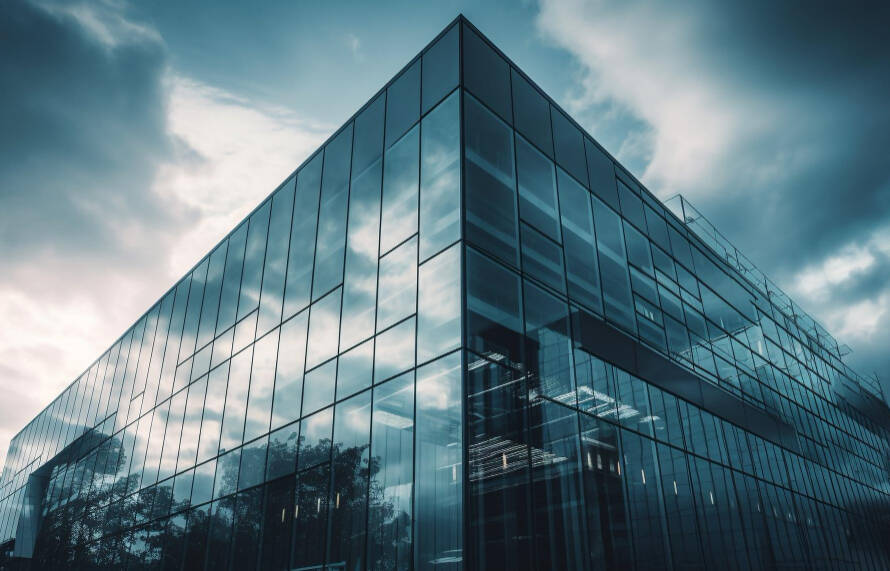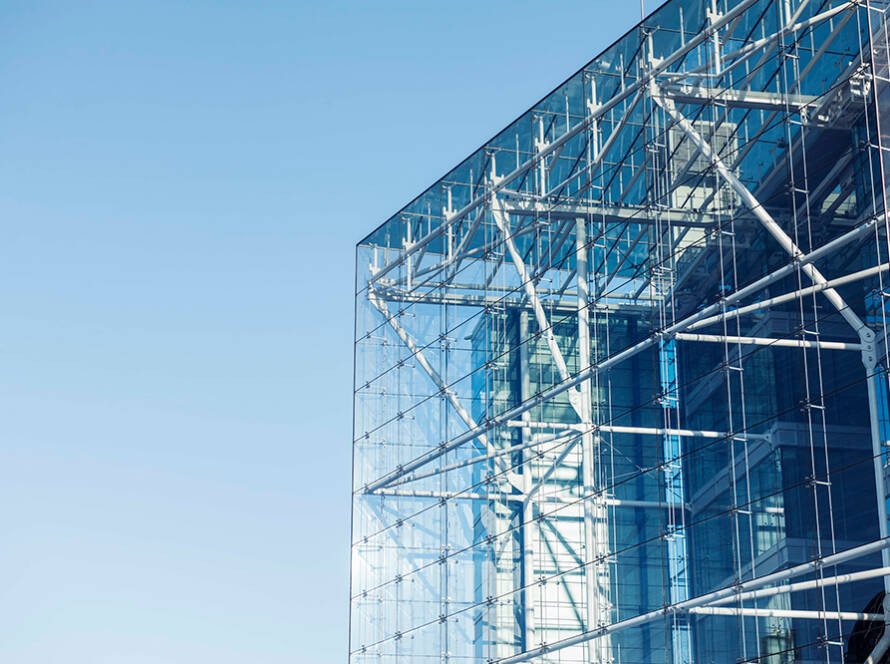What is Architectural Glass? and What does its Signify?
Glass used in building construction is called architectural glass. This stuff is used a lot to make windows in the outside walls of buildings. Glass is used in architecture and for interior walls.This glass is used for more than just windows, doors, skylights, facades, and interior walls. The aim of architectural glass design and production is to meet the needs of modern architecture in terms of both function and appearance.
In the case of function architectural glass can provide improved strength and extreme safety features , like prevention of being shattered through proper laminating and tempering . As a great plus point it has thermal insulation properties that will help to control indoor temperatures and lead to improved energy efficiency.
In addition it also has a soundproofing feature that will help to lower the noise pollution that arises from the external environment.
Architectural glass indeed provides a wide range of aesthetic touch in case of styles, colours, textures that enables architects and designers to gain the visual effects according to their desires.
Advanced technological treatments, such as low-end coatings (low E), can further enhance the performance of architectural glass by allowing light to reflect heat. This makes architectural glass an integral part of a sustainable building design, providing energy-efficient and natural balanced lighting.
Overall, architectural glass plays an important role in modern architecture, combining practical features with simple design to create buildings that are both functional and visually appealing.
Features Of Architectural Glass

In the world of today’s architectural design there is no element that can be experienced as having as much potential for change as architectural glass. Besides simply serving as a clear invisible divider between the inside and the outside or between zones, architectural glass offers numerous values that change the conception of apartments, improve energy efficiency, and make the architectural appearance richer. Ranging from accentuating structures’ strength and safety to featuring state-of-the-art energy-saving characteristics, architectural glass is the perfect combination of both form and function.
Let’s explore the many facets of architectural glass, which dissects its ability to inform the design of surrounding environments, prod designers into new avenues of creation, and further advance the design of architecture. Together, let us discuss the phenomenal characteristics that have placed architectural glass as one of the primary foundations of contemporary building projects and a platform for designers’ creativity.
- Strength and Safety: Architectural glass is often treated to increase its strength and safety. Techniques such as tempering and lamination ensure that the glass is shock resistant, and breaks down into less damaging pieces when broken, reducing the risk of injury
- Thermal Insulation: This glass is designed to improve the thermal insulation of buildings. By reducing heat loss, architectural glass helps maintain comfortable indoor temperatures and contributes to energy efficiency, reducing heating and cooling costs
- Soundproofing: Architectural glass can be filled for soundproofing. This is especially beneficial in urban areas where it helps reduce outside noise, creating a calm and relaxed atmosphere.
- Aesthetic Versatility: Available in a variety of styles, colours and finishes, architectural glass provides essential aesthetic versatility. Artists and designers can use clear, polished, shaded, or patterned glass to achieve a specific visual effect and improve the overall appearance of a building.
- UV protection: several architecture glasses are made in order to restrict the entry of harmful UV rays. This feature will help interior furnishing to prevent fading and the chance of issues related to occupants.
- Durability: Designed to withstand environmental stresses, architectural glass is highly durable. It resists weathering, corrosion, and other forms of degradation, ensuring a long lifespan and maintaining its appearance over time.
Let's See The Different Varieties Of Architectural Glasses
There are different varieties of architecture glass according to our situational need and our interest.the major varieties are discussed below
Types
1. Strengthened glass

Tempered glass is another type of glass that is treated with heat to increase its measure of the hardness and durability than any other glasses. It is also a safer product compared to other laminates because when it breaks it does into small pieces and not sharp pieces hence they can be used in doors and windows and in any other construction.
2. Laminated Glass

Actually laminated glass can be made up of two or more glass pilgrim’s with aerated middle layer most common of which is polyvinyl butyral (PVB). It is employed in holding in place objects and shielding them and thus, it is applied in quantity in skylights, windshields, and other regions that require soundproofing.
3. Insulated Glass Unit (IGU)

Insulated glasses are made in such a way that one or more glass panes are separated by a space or by a cavity that can contain air or plenum chamber. With less heat conduction and heat retaining, the thermal insulation and energy economy are therefore improved and thus, this design is best suited for windows and the facade of cloud winds regarding climate change.
4. Low Emission (Low-E) Glass

It redirects heat back to the building when it is extremely cold outside but, cannot allow heat if it is hot outside. It can permanently save the cost of heating-cooling since it can be used on windows and doors of energy efficient structures.
5. Colored Glass

To eliminate glare and heat build up, colour is incorporated into coloured glass at the manufacturing stage. It aids in regulating the increase in temperature, offers shades and lowers the effects of the UV rays. It can shield the furniture from the fading process and is applicable to the outer walls and skylights mostly.
6. Reflective Glass

It has a metallic coating on the outer side to reflect a portion of incoming radiation from the sun ; thus the amount of heat and glare entering the room from the outer layer is limited. This is common in office buildings and trades as a way to ensure privacy and is mostly used on towers and buildings during the day mostly to enhance energy and looks.
7. Frosted glass

Frosted glass is either chemically treated with acid or sand/rubber blasted to give it the smooth opaque frosted finish that diffuses light. It lets the light pass through it while at the same time offering privacy, typical application in bathrooms, offices and as a décor.
8. Patterned Glass

Patterned glass has textures or patterns that are arranged on one or both of the sides and these patterns work to give designs on the glass while at the same time dispersing the light. It is employed for beautification where the walls are partitioned, doors and windows, if one desires to have some privacy and enhancement of beauty.
9. Smart Glass (Switchable Glass)

Smart glass can be made to vary density either in response to an electric, light or heat impulse. This technology which permits the regulating of transmitted light and heat at times requires privacy, saving energy when needed, is employed in window, skylights, and interior dividing walls.
10. Fire Resistant Glass

Fire resistant glass is that in which arrangements have been made to provide high tolerances and resist the distribution of flame and smoke. It is often utilised in fire doors, windows and partitions to enhance the safety of the building whereby in the event of a fire the escape time is significantly boosted.
Where Do We Actually Use These Glasses ?
AREAS OF APPLICATION
The dynamics of ever-growing innovations in assembly and designing of the architectural glass cannot be overshadowed. The usage of architectural glass can be seen in the range starting from business and commercial buildings such as high rise buildings and ending with residential construction including houses. Aside from its function to provide beauty to any structure, this material also becomes very vital in its main purpose of providing energy saving, natural lighting and the promotion of space creation with interactive designs. While exploring the extensive applications of architectural glass to the extent that it influences our formed reality, its importance to different sectors and the way in which it transforms environmental perception is found.
- Windows and Facades: The most common application of architectural glass is in construction in the window and building façade for the admission of natural light with an architectural feel and for energy conservation. Other sophisticated varieties like Insulated glass units (IGUs) and Low-emissivity (Low-E) glasses assist decreasing heat transmission, and hence assist in managing comfort temperatures besides cutting the costs of energy.
- Doors and Entrances: Those that are laminated with glass offer a fashionable look and feel to the building as well as ensure that light is permitted into rooms with doors and entrances made of glass. Therefore, in these areas, and especially when designing with glass, tempered and laminated glass provide safety.
- Skylights and Roof Glazing: Skylights and roof glazing are the constructions that allow the use of architectural glass to bring daylight into a building, thus minimising the necessity to use electric lighting. Laminated and tinted glasses are flown in these applications to regulate heat input and enhance the safety of the building.
- Interior Partitions and Walls: Aesthetic office dividers from glass offer the visibility into not only a more inviting space, but also create a closed and private environment that is effective at shutting out noise when necessary. Frosted glass, patterned glass, and smart glass are selective types of glasses which can be preferably used in offices, conference rooms, and house decorations.
- Balustrades and Railings: They are modern and elegant and give a much needed safety barrier without obstructing the view. Tempered and laminated glasses are normally applied in these uses as they are strong and can withstand impact for long.
- Shower Enclosures and Bathroom Features: In addition, architectural glass can be seen in the shower enclosures, mirrors as well as partitions mainly in the context of bathrooms taken as elegant and contemporary. Tinted and textured glass is used to provide maximum privacy as well as let in light into the room.
- Commercial Storefronts and Display Windows: There are those clear, tinted or reflecting classes usually used in constructing storage and display areas of various buildings like shops for the general display of their items and comfortable shopping background. These characteristics ensure that the new generation of glass offers improved energy conservation and protection of business entities’ assets.
- Atriums and Canopies: Glass is often used in the design of both atriums and canopies which create open areas that let in a great amount of light and bring the outside in. Other types of glass include lamination and UV protected glass that make provision for security and protection from other odds of nature like the ultraviolet light.
- Sound Barriers and Acoustic Solutions: Acoustic glass can be used in barriers that may include; sound walls, sound fences and in interior decorating. Such kind of glass is particularly effective in populated areas, along the roads, and in constructions which need the acoustic wall.
- Fire-Rated Windows and Doors: Tempered glass is the kind of glass used in the window and doors that have undergone several points concerning the regulation of fire safety so that in the event that a fire occurs, certain protection is provided. These applications are essential in; Stairwells Corridors, and any other area that require compartmentation to prevent the expansion of fire and smoke.
Thus, the discussed application areas clearly illustrate the unreplaceable significance of architectural glass in modern architecture. Used as glazing in windows and façade for energy efficiency, in partitions that provide openness in space, or as a fire resistant enclosure for safety, architectural glass solutions are virtually limitless. Widely applied in construction, yet possessing great functionality, appealing appearance, and endurance, architectural glass remains an uprising of creativity and style. As contemporary architectural space changes constantly as a unique and promising territory for construction yet to come, it is possible to observe that architectural glass is still widely contributing to the overall formation of new architectural space for further generations.
Need To Know More About Architectural Glasses ?
For those who are looking for a company that would be a one-stop company for everything architectural glass related then TPRS Glass Solutions Enterprise is a company to turn to. As a company that focuses on ensuring that their designs meet specific client requirements, their group of professionals guarantees strong cooperation as well as the efficient translation of a client’s vision. As for successful implementation of the modern proposals and working with numerous clients, TPRS Glass Solutions Enterprise provides expert assistance to help clients choose the most suitable architectural glass. For more information and to start exploring the change in the capability of design and implementation, contacting TPRS Glass Solutions Enterprise is informative, not to mention a commitment of a partnership aiming to bring into existence the architect’s imagination.





